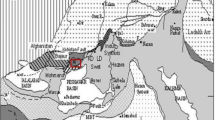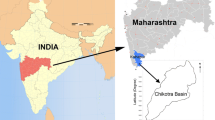Abstract
Knowledge of the existence of fracture zones, their extent, intensity and direction is very useful for assessing groundwater in hardrock regions and in this context geophysical methods are widely accepted as a powerful means of study. In the modern era of exploration, application of the Resistivity Imaging technique gives a new opportunity for groundwater study in hardrock regions. Exploration surveys were conducted at one of the important sites in Maheshwaram watershed, Andhra Pradesh, India with a multielectrode resistivity imaging system. To reduce the ambiguity of geophysical interpretation some complementary geophysical studies like ground Magnetic and VLF were also carried out.
A number of 2D resistivity images were prepared in a grid pattern, which clearly show the weathered and fractured zones in different parts of the study area. With the help of all 2D profiles a quasi-3D image has been created, which indicates the orientation and extension of the fracture zone in a horizontal as well as vertical direction in the study area. Strong agreement exists among the anomalies identified using the ground magnetic, VLF and resistivity imaging methods. The litholog data available in the study area also helps to interpret geophysical results to find a potential groundwater bearing zone in that area.
Résume
La présence des zones fracturées, leur extension ainsi que leur intensité et direction est très utile pour l’évaluation des eaux souterraines cantonnées dans les roches dures. Dans ce contexte, les méthodes géophysiques sont largement acceptées comme des instruments performants pour l’étude de ce type de problème. La technique de “Resistivity imaging” offre une perspective nouvelle pour la prospection des eaux souterraines cantonnées dans les massifs rocheux. On a utilisé la méthode des images résistives multi électrodes pour la prospection d’un site important dans le bassin versant de Andhra Paresh de l’Inde. Afin de réduire l’ambiguïté de l’interprétation géophysique on a utilisé aussi des méthodes complémentaires comme la magnetométrie et VLF. Des images de résistivité réalisées dans des réseaux bidimensionnelles ont mis en évidence avec beaucoup de clarté les zones altérées et fracturées dans le site étudié. En utilisant toute les coupes 2D on a réalisé une image quasi-3D qui indique l’orientation et l’extension de la zone fracturé dans les plans verticaux et horizontaux. Il y a un bon accord entre les anomalies identifiées par la magnétométrie, la VLF et la méthode des images résistive. Les données de litholog disponibles dans la zone étudiée permettent de mieux interpréter les résultats géophysiques pour mettre en évidence les potentielles hydrostructures dans le site étudié.
Resumen
El conocimiento de la existencia de zonas de fractura, su extensión, intensidad y dirección, es muy útil para evaluar el agua subterránea en regiones con rocas duras y en este contexto los métodos geofísicos son ampliamente aceptados como medios de estudio poderosos. En la era moderna de la exploración, la aplicación de la técnica de proyección de imágenes de resistividad, da una nueva oportunidad para el estudio del agua subterranean en regiones con rocas duras. Las investigaciones exploratorias fueron ejecutadas en uno de los sitos importantes en la cuenca de Maheshwaram,Andhra Pradesh, india, con un sistema multielectródico de resistividad con proyección de imágenes. Para reducir la ambigüedad en la interpretación geofísica, también fueron ejecutados algunos estudios geofísicos complementarios, como magnetometría de superficie y VLF.
Un número de imágenes de resistividad 2D se preparó en forma reticular, las cuales muestran de manera clara las zonas fracturadas y meteorizadas en diferentes partes del área de estudio. Con la ayuda de todos los perfiles 2D, fue creada una cuasi - imagen 3D, la cual indica para el área de estudio, la orientación y extensión de la zona de fracturas, tanto en dirección horizontal, como en la vertical. Hay una fuerte coincidencia entre las anomalías identificadas mediante el uso de la magnetometría de superficie, el método VLF y el de la proyección de imágenes de resistividad. La información litológica que se pudo obtener en el área de estudio, también ayudó a interpretar los resultados geofísicos, para encontrar en ésta área una zona que potencialmente contenga agua subterránea.







Similar content being viewed by others
References
Acworth RI (1987) The development of crystalline basement aquifers in a tropical environment. Quart J Eng Geol 20:265–272
Barker RD, Rao TV, Thangarajan M (2003) Application of Electrical imaging for borehole siting in hard rock regions of India. JGSI 61:147–158
Benson KA, Payne LK, Stubben MA (1997) Mapping groundwater contamination using dc resistivity and VLF geophysical methods-A case study. Geophysics 62:80–86
Bernard J, Valla P (1991) Groundwater exploration in fissured media with electrical and VLF methods. Geoexploration 29:81–91
Dahlin T, Loke MH (1997) Quasi-3D resistivity imaging mapping of three-dimensional structures using two-dimensional resistivity imaging technique. Proceedings 3rd meeting on Environmental and Engineering geophysics, Aarhus, Denmark, 8–11 Sept, 1997
DeGroot-Hedlin C, Constable S (1990) Occam’s inversion to generate smooth, two-dimensional models from magnetotelluric data. Geophysics 55:1613–1624
Ellis RG, Oldenburg DW (1994) Applied geophysical inversion. Geophys J Intern 116:5–11
Grifiths DH, Barker RD (1993) Two-dimensional resistivity imaging and modeling in areas of complex geology. J Appl Geophys 29:211–226
Hautot S, Tarits P, Perrier F, Tarits C, Trique M (2002) Groundwater electromagnetic imaging in complex geological and topographical regions: A case study of a tectonic boundary in the French Alps. Geophysics 67:1048–1060
Ionnis FL, Filippos IL, Grambas A (2002) Exploring for favorable ground water conditions in hardrock environments by resistivity imaging methods: synthetic simulation approach and case study example. ICESE-2002
Kearey P, Brooks M, Hill I (2002) An Introduction to Geophysical Exploration, 3rd edn. Blackwell Science, Oxford
Loke MH, Barker RD (1995) Leastsquares deconvolution of apparent resistivity pseudosections. Geophysics 60(6):1682–1690
Marechal JC, Dewandel B, Subrahmanyam K (2004) Use of Hydraulic tests in different scales to characterize fracture network properties in the weathered fractured layer of a hard rock aquifer. Submitted to Water Resources Research
Mendoza A, Bjelm L, Dahlin T (2000) Resistivity imaging as a tool for groundwater studies at Santo Domingo, Central Nicaragua. EEGS’00 Bochum, Germany
Paterson NR, Ronka V (1971) Five years of surveying with very low frequency- electromagnetic method. Geoexpl 9:7–26
Smith BD, Ward SH (1974) On the computation of polarization ellipse parameters. Geophysics 39:867–869
Acknowledgement
The Authors express their thanks to the Director, NGRI for his kind permission for carrying out the study. This work was carried out in a project partly funded by the Indo-French Center for Advance Research (IFCPAR), New Delhi
Author information
Authors and Affiliations
Corresponding author
Rights and permissions
About this article
Cite this article
Dutta, S., Krishnamurthy, N.S., Arora, T. et al. Localization of water bearing fractured zones in a hard rock area using integrated geophysical techniques in Andhra Pradesh, India. Hydrogeol J 14, 760–766 (2006). https://doi.org/10.1007/s10040-005-0460-7
Received:
Accepted:
Published:
Issue Date:
DOI: https://doi.org/10.1007/s10040-005-0460-7




